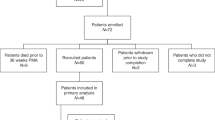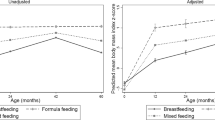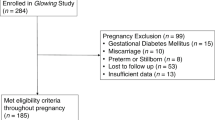Abstract
Background
This study longitudinally characterized the developmental status, growth, and body composition of children who were fed human milk (breastfed, BF), cow’s milk-based (MF), or soy protein-based (SF) infant formula from 3 to 12 months.
Methods
Standardized anthropometrics and dual-energy X-ray absorptiometry were used to characterize growth and body composition at 3, 6, 9, 12, 24, 36, 48, 60, and 72 months (NCT00616395). Preschool Language Scale-3, Children’s Memory Scale Index (CMS), and Wechsler Preschool and Primary Scale of Intelligence were administered at age 72 months. Mixed-effects models adjusting for gestational age, birth weight, child race and sex, parental education, and maternal IQ were performed.
Results
Body Mass index (BMI) was significantly lower between 24 and 72 months in BF children compared to SF children. At 3 and 6 months, BF infants had significantly higher fat mass (FM) than SF infants, whereas BF children had significantly lower FM at 36 and 48 months than SF children. Delayed Recognition Index of the CMS was higher for SF than for MF participants (p = 0.009). There was no other significant difference in developmental outcomes between groups.
Conclusions
In conclusion, BF, MF, and SF support adequate growth and development up to age 6 years.
Impact
-
Although soy protein-based infant formula is reported to support normal infant growth and development compared to cow’s milk-based formula and human milk, there are limited data on the effect of these feeding methods in school-aged children.
-
This study suggests a significant difference in body composition, specifically BMI, after 24 months between infant feeding methods during the first year of life and in early childhood; however, all diets provide adequate nutrients to maintain normal development up to 72 months.
Similar content being viewed by others
Log in or create a free account to read this content
Gain free access to this article, as well as selected content from this journal and more on nature.com
or
Data availability
Deidentified individual participant data will not be made available.
References
Bhatia, J., Greer, F. & Committee on Nutrition. Use of soy protein-based formulas in infant feeding. Pediatrics 121, 1062–1068 (2008).
Andres, A., Casey, P. H., Cleves, M. A. & Badger, T. M. Body fat and bone mineral content of infants fed breast milk, cow’s milk formula, or soy formula during the first year of life. J. Pediatr. 163, 49–54 (2013).
American Academy of Pediatrics. Infant feeding timeline, AAP Health initiatives. https://www.aap.org/en-us/advocacy-and-policy/aap-health-initiatives/HALF-Implementation-Guide/Age-Specific-Content/Pages/Infant-Timeline.aspx (2019).
Badger, T. M. et al. The health implications of soy infant formula. Am. J. Clin. Nutr. 89, 1668S–1672S (2009).
Merritt, R. J. & Henks, B. H. Safety of soy-based infant formulas containing isoflavones: the clinical evidence. J. Nutr. 134, 1220S–1224S (2004).
Rossen, L. M., Simon, A. E. & Herrick, K. A. Types of infant formulas consumed in the United States. Clin. Pediatr. 55, 278–285 (2016).
Messina, M., Rogero, M. M., Fisberg, M. & Waitzberg, D. Health impact of childhood and adolescent soy consumption. Nutr. Rev. 75, 500–515 (2017).
Andres, A. et al. Developmental status of 1-year-old infants fed breast milk, cow’s milk formula, or soy formula. Pediatrics 129, 1134–1140 (2012).
Wechlsler, D. Wechsler Preschool and Primary Scale of Intelligence - Third Edition (The Psychological Corporation, San Antonio, TX, 2002).
Zimmerman, I. L., Steiner, V. G. & Pond, R. E. Preschool Language Scale 3rd Edition (The Psychological Corporation, San Antonio, TX, 1992).
Cohen, M. J. Children’s Memory Scale (The Psychological Corporation, San Antonio, TX, 1997).
Heard-Lipsmeyer, M. E. et al. Evaluating body composition in infancy and childhood: a comparison between 4C, QMR, DXA, and ADP. Pediatr. Obes. 15, e12617 (2020).
Kelly, T. L., Wilson, K. E. & Heymsfield, S. B. Dual energy X-ray absorptiometry body composition reference values from NHANES. PLoS ONE 4, e7038 (2009).
Rzehak, P. et al. Infant feeding and growth trajectory patterns in childhood and body composition in young adulthood. Am. J. Clin. Nutr. 106, 568–580 (2017).
Owen, C. G. et al. Effect of infant feeding on the risk of obesity across the life course: a quantitative review of published evidence. Pediatrics 115, 1367–1377 (2005).
Owen, C. G. et al. The effect of breastfeeding on mean body mass index throughout life: a quantitative review of published and unpublished observational evidence. Am. J. Clin. Nutr. 82, 1298–1307 (2005).
Butte, N. F. Impact of infant feeding practices on childhood obesity. J. Nutr. 139, 412S–416S (2009).
Rolland-Cachera, M. F., Akrout, M. & Peneau, S. Nutrient intakes in early life and risk of obesity. Int. J. Environ. Res. Public Health 13, 564 (2016).
Gale, C. et al. Effect of breastfeeding compared with formula feeding on infant body composition: a systematic review and meta-analysis. Am. J. Clin. Nutr. 95, 656–669 (2012).
Ntalla, I. et al. Body composition and eating behaviours in relation to dieting involvement in a sample of urban Greek adolescents from the TEENAGE (TEENs of Attica: Genes & Environment) study. Public Health Nutr. 17, 561–568 (2014).
Deheeger, M. et al. Individual patterns of food intake development in children: a 10 months to 8 years of age follow-up study of nutrition and growth. Physiol. Behav. 59, 403–407 (1996).
Vandenplas, Y. et al. Safety of soya-based infant formulas in children. Br. J. Nutr. 111, 1340–1360 (2014).
Rolland-Cachera M. F. & Scaglioni, S. Role of Nutrients in Promoting Adiposity Development (ECOG, 2016).
Michaelsen, K. F. & Greer, F. R. Protein needs early in life and long-term health. Am. J. Clin. Nutr. 99, 718S–722S (2014).
Hornell, A., Lagstrom, H., Lande, B. & Thorsdottir, I. Protein intake from 0 to 18 years of age and its relation to health: a systematic literature review for the 5th Nordic Nutrition Recommendations. Food Nutr. Res. 57 (2013).
Haisma, H. et al. Breast milk and energy intake in exclusively, predominantly, and partially breast-fed infants. Eur. J. Clin. Nutr. 57, 1633–1642 (2003).
Mortensen, E. L., Michaelsen, K. F., Sanders, S. A. & Reinisch, J. M. The association between duration of breastfeeding and adult intelligence. JAMA 287, 2365–2371 (2002).
Horta, B. L., Loret de Mola, C. & Victora, C. G. Breastfeeding and intelligence: a systematic review and meta-analysis. Acta Paediatr. 104, 14–19 (2015).
Colen, C. G. & Ramey, D. M. Is breast truly best? Estimating the effects of breastfeeding on long-term child health and wellbeing in the United States using sibling comparisons. Soc. Sci. Med. 109, 55–65 (2014).
Lund, T. D. et al. Visual spatial memory is enhanced in female rats (but inhibited in males) by dietary soy phytoestrogens. BMC Neurosci. 2, 20 (2001).
Wells, J. C. & Fewtrell, M. S. Measuring body composition. Arch. Dis. Child 91, 612–617 (2006).
Acknowledgements
The authors are grateful to the children and families who participated in this study and to the clinical core team for their assistance in data collection. All phases of this study were supported by USDA-ARS Project 6026-51000-010-05S.
Author information
Authors and Affiliations
Contributions
S.S. drafted the initial manuscript, interpreted the data, and reviewed and revised the manuscript. A.A. contributed to the conceptualization and design of study, coordinated and supervised data collection, analyzed and interpreted data, and contributed to the writing and review of the manuscript. T.M.B. and P.H.C. conceptualized, designed the study, and reviewed manuscript. C.R.S. and D.K.W. analyzed and interpreted the data and reviewed manuscript. J.B. coordinated and supervised data collection and reviewed manuscript. G.M. performed data collection, analyzed and interpreted data, and contributed to the writing of the manuscript. S.T.S. supervised data collection and reviewed the manuscript. All authors reviewed the manuscript critically for important intellectual content and approved the final manuscript as submitted and agree to be accountable for all aspects of the work.
Corresponding author
Ethics declarations
Competing interests
The authors declare no competing interests.
Consent
Consent was obtained prior to study procedures. The study was approved by the Institutional Review Board of the University of Arkansas for Medical Sciences.
Additional information
Publisher’s note Springer Nature remains neutral with regard to jurisdictional claims in published maps and institutional affiliations.
Supplementary information
Rights and permissions
About this article
Cite this article
Sobik, S., Sims, C.R., McCorkle, G. et al. Early infant feeding effect on growth and body composition during the first 6 years and neurodevelopment at age 72 months. Pediatr Res 90, 140–147 (2021). https://doi.org/10.1038/s41390-020-01157-z
Received:
Revised:
Accepted:
Published:
Issue date:
DOI: https://doi.org/10.1038/s41390-020-01157-z
This article is cited by
-
Differential associations between body composition indices and neurodevelopment during early life in term-born infants: findings from the Pakistan cohort: Multi-Center Body Composition Reference Study
European Journal of Clinical Nutrition (2024)
-
Tailored recommendations for infant milk formula intake results in more accurate feeding
European Journal of Pediatrics (2024)
-
Alternativen zu Säuglingsnahrungen auf Kuhmilchproteinbasis
Monatsschrift Kinderheilkunde (2023)
-
Unexpected content of kynurenine in mother’s milk and infant formulas
Scientific Reports (2022)



